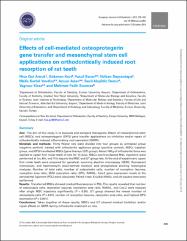Effects of cell-mediated osteoprotegerin gene transfer and mesenchymal stem cell applications on orthodontically induced root resorption of rat teeth

View/
Access
info:eu-repo/semantics/openAccessDate
2017Author
Amuk, Nisa GulKurt, Gokmen
Baran, Yusuf
Seyrantepe, Volkan
KARTAL YANDIM, Melis
Adan, Aysun
Akyildiz Demir, Secil
Kiraz, Yagmur
Sonmez, Mehmet Fatih
Metadata
Show full item recordCitation
EUROPEAN JOURNAL OF ORTHODONTICS Volume: 39 Issue: 3 Pages: 235-242 DOI: 10.1093/ejo/cjw054Abstract
Aim: The aim of this study is to evaluate and compare therapeutic effects of mesenchymal stem cell (MSCs) and osteoprotegerin (OPG) gene transfer applications on inhibition and/or repair of orthodontically induced inflammatory root resorption (OIIRR). Materials and methods: Thirty Wistar rats were divided into four groups as untreated group (negative control), treated with orthodontic appliance group (positive control), MSCs injection group, and OPG transfected MSCs [gene therapy (GT) group]. About 100 g of orthodontic force was applied to upper first molar teeth of rats for 14 days. MSCs and transfected MSC injections were performed at 1st, 6th, and 11th days to the MSC and GT group rats. At the end of experiment, upper first molar teeth were prepared for genetical, scanning electron microscopy (SEM), fluorescent microscopy, and haematoxylin eosin-tartrate resistant acid phosphatase staining histological analyses. Number of total cells, number of osteoclastic cells, number of resorption lacunae, resorption area ratio, SEM resorption ratio, OPG, RANKL, Cox-2 gene expression levels at the periodontal ligament (PDL) were calculated. Paired t-test, Kruskal-Wallis, and chi-square tests were performed. Results: Transferred MSCs showed marked fluorescence in PDL. The results revealed that number of osteoclastic cells, resorption lacunae, resorption area ratio, RANKL, and Cox-2 were reduced after single MSC injections significantly (P < 0.05). GT group showed the lowest number of osteoclastic cells (P < 0.01), number of resorption lacunae, resorption area ratio, and highest OPG expression (P < 0.001). Conclusions: Taken together all these results, MSCs and GT showed marked inhibition and/or repair effects on OIIRR during orthodontic treatment on rats.

















